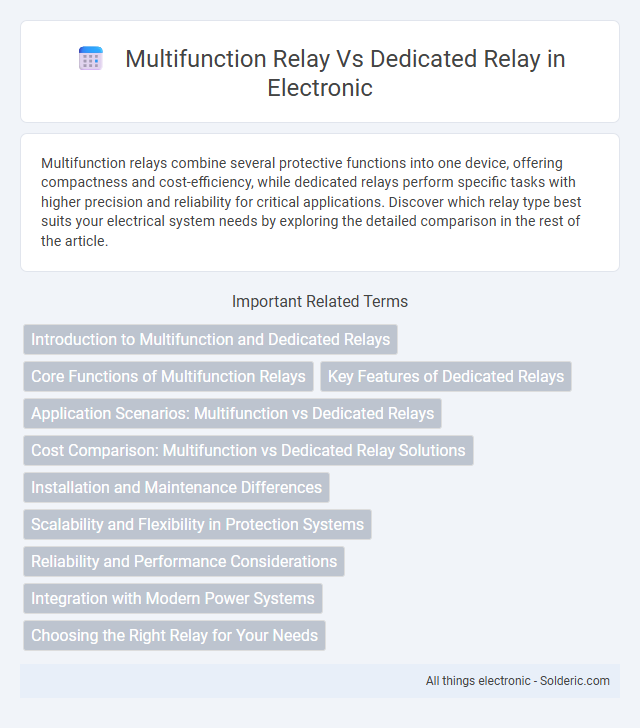Multifunction relays combine several protective functions into one device, offering compactness and cost-efficiency, while dedicated relays perform specific tasks with higher precision and reliability for critical applications. Discover which relay type best suits your electrical system needs by exploring the detailed comparison in the rest of the article.
Comparison Table
| Feature | Multifunction Relay | Dedicated Relay |
|---|---|---|
| Purpose | Combines multiple relay functions in one device | Performs a single, specific relay function |
| Flexibility | High - configurable for various applications | Low - fixed function, limited adaptability |
| Cost | Higher initial cost due to multifunctionality | Lower cost, but may require multiple devices for complex tasks |
| Installation | Simplifies wiring by reducing number of devices | Requires more wiring and space for multiple relays |
| Maintenance | Potentially more complex troubleshooting | Simple and straightforward maintenance |
| Applications | Used in systems requiring multiple protections or control functions | Ideal for single-function applications |
| Example | Protection relays combining overcurrent, undervoltage, and earth fault | Standard on/off relay or single protection type |
Introduction to Multifunction and Dedicated Relays
Multifunction relays combine multiple protection and control functions within a single device, enhancing efficiency and reducing the need for numerous standalone components in power systems. Dedicated relays are specialized devices designed for a specific protection or control task, providing focused, reliable performance for individual functions such as overcurrent or distance protection. Choosing between multifunction and dedicated relays depends on system complexity, cost considerations, and maintenance preferences in electrical network management.
Core Functions of Multifunction Relays
Multifunction relays integrate protection, control, and monitoring functions into a single device, offering versatile operation for power systems. Core functions include overcurrent, undervoltage, frequency protection, and automation capabilities, enabling efficient fault detection and system management. Your power network benefits from reduced equipment complexity and enhanced reliability compared to dedicated relays designed for specific protection tasks.
Key Features of Dedicated Relays
Dedicated relays offer specialized functionality tailored for specific applications, ensuring high precision and reliability in tasks such as motor control, lighting, and safety circuits. These relays feature fixed configurations and optimized contact arrangements that enhance switching speed and minimize electrical noise. Their simplified design reduces complexity and improves durability, making them ideal for consistent, repetitive operations in industrial and commercial environments.
Application Scenarios: Multifunction vs Dedicated Relays
Multifunction relays offer versatile protection and control capabilities ideal for complex electrical systems requiring integrated functions like overcurrent, earth fault, and voltage monitoring in industrial plants and substations. Dedicated relays, designed for specific protection tasks such as overcurrent or motor protection, excel in applications where simplicity, cost-effectiveness, and fast response are critical, such as in smaller facilities or single-purpose machines. Choosing between multifunction and dedicated relays depends on system complexity, scalability needs, and protection coordination requirements across residential, commercial, or utility environments.
Cost Comparison: Multifunction vs Dedicated Relay Solutions
Multifunction relays typically reduce overall costs by combining multiple protective functions into a single device, lowering both equipment and installation expenses. Dedicated relays, while often more expensive due to specialized hardware for each protection task, may offer greater precision and reliability in critical applications. Your choice between multifunction and dedicated relay solutions should balance upfront investment with long-term operational efficiency and maintenance costs.
Installation and Maintenance Differences
Multifunction relays consolidate several protective and control functions into a single device, simplifying installation by reducing wiring complexity and panel space requirements compared to dedicated relays that perform specific tasks individually. Maintenance for multifunction relays often involves software updates and diagnostic checks, while dedicated relays require separate inspections and calibrations for each device, increasing labor and downtime. The integrated nature of multifunction relays enables streamlined fault detection and faster troubleshooting, enhancing overall system reliability and maintenance efficiency.
Scalability and Flexibility in Protection Systems
Multifunction relays offer greater scalability and flexibility compared to dedicated relays, as they can perform multiple protective functions within a single device, reducing the need for separate relays for each protection task. Your protection system can be easily expanded or modified by reconfiguring parameters in a multifunction relay, while dedicated relays require physical replacement or additional units to achieve similar adaptability. This flexibility allows for optimized system design and streamlined maintenance, saving space and costs in evolving power networks.
Reliability and Performance Considerations
Multifunction relays integrate multiple protection and control functions into a single device, offering enhanced reliability through built-in diagnostics and reduced hardware complexity, which minimizes failure points. Dedicated relays provide specialized and optimized performance for specific protection tasks, often ensuring faster response times and easier troubleshooting due to their singular focus. Reliability in multifunction relays depends on the robustness of embedded software and firmware updates, while dedicated relays benefit from proven, application-specific hardware to maintain high-performance standards in critical protection schemes.
Integration with Modern Power Systems
Multifunction relays offer seamless integration with modern power systems by combining protection, control, and monitoring functions into a single device, reducing complexity and installation costs. These relays support advanced communication protocols like IEC 61850, enabling real-time data exchange and remote diagnostics, which enhance system reliability and efficiency. Your power system benefits from faster fault detection and flexible configuration compared to dedicated relays, which typically handle only one specific function.
Choosing the Right Relay for Your Needs
Choosing the right relay depends on the specific application requirements, where multifunction relays offer versatility by combining multiple functions like timing, overload protection, and control in a single device. Dedicated relays provide specialized performance optimized for a singular task, ensuring reliability and simplicity in systems requiring minimal functions. Evaluating factors such as the complexity of control, space constraints, and budget can help determine whether a multifunction relay or a dedicated relay is the best fit for your electrical system.
Multifunction relay vs dedicated relay Infographic

 solderic.com
solderic.com